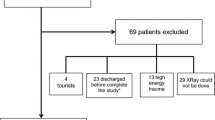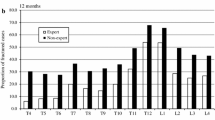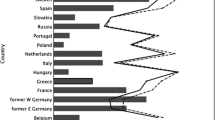Summary
□Background: Radiologically identified vertebral deformities, e. g. wedge-, fish-, or crush-vertebrae are not always a consequence of local osteoporosis. Other frequent pathomechanisms include Morbus Scheuermann, degenerative changes, overt trauma, and congenital dysplasia. This requires differential diagnosis of vertebral deformities. Radiological classification criteria have to satisfy various methodological requirements to ensure reliability of the results.
□Methods: Inter-rater reliability of more than 30 radiological findings was assessed in 4 German centres of the European Vertebral Osteoporosis Study (EVOS). One hundred randomly selected EVOS cases from the West-Berlin population, each contributing 2 lateral X-rays from the thoracic and lumbar spine respectively, were independently evaluated by 7 observers. All observers were medical doctors, 4 of them heads or members of clinical radiological departments. Thus each observer read 200 radiographs. Radiological alterations in the form and structure of 13 vertebrale which were considered to be relevant for the differential diagnosis of osteoporosis were recorded in a standardized documentation form. Additionally global judgements (e. g. “osteoporotic spine” yes/no) were required. To quantify agreement Fleiss’ kappa (κ) for nominal data and multiple observers was used.
□Results: Only 4% of all vertebral columns were stated as “normal”, 25% as “osteoporotic”. This last figure exceeded more than 2-fold the prevalence of significant vertebral deformities, as based on semiautomatic morphometry (about 10%). Wedge deformities were found on average in 39% of all thoracic and 5% of all lumbar X-rays with ranges of 20% to 53% and 2% to 10% respectively among 7 observers. For both variables, agreement (κ) between the observers was below 0.40. The highest agreement was found for the assessment of fractures of the upper and/or lower lamina of lumbar vertebrae (κ=0.58). Agreement did not vary between radiologists and non-radiologists. Higher κ-values were recorded for observers working in the same centre (0.50 to 0.90).
□Conclusion: There is an urgent need for the differential diagnosis of vertebral deformities which in half of all cases may be caused by vertebral osteoporosis. The low inter-rater reliability of 30 radiological characteristics seriously interferes with this task. Moderate to good agreement was seen only among observers coming from the same centre. It may be concluded that a more intensive training is likely to lead to better agreement. However, this is a time and resource consuming option. It may be equally appropriate to include further information from other sources such as bone mass measurement to identify osteoporosis related vertebral deformities. In the meantime, prevalence estimations and case control studies based solely on vertebral morphometry have to be interpreted with caution.
Similar content being viewed by others
Literature
Bortz J, Lienert GA, Boehnke K. Verteilungsfreie Methoden in der Biostatistik, erste Auflage. Berlin-Heidelberg-New York: Springer, 1990:454–8.
Coste J, Paolaggi JB, Spira A. Reliability of interpretation of plain lumbar spine radiographs in benign, mechanical low-back pain. Spine 1991;16:426–8.
Deyo RA, McNiesh LM, Cone RO. Observer variability in the interpretation of lumbar spine radiographs. Arthritis Rheum 1985;28:1066–70.
Jensen GF, McNair P, Hegedüs V. Validity in diagnosing osteoporosis. Europ J Radiol 1984;4:1–3.
Lawrence JS. Rheumatism in populations. London: William Heinemann Medical Books LTD, 1977.
McCloskey EV, Spector TD, Eyres KS et al. Assessment of vertebral deformity validation of a new method with high specifity. J Bone Miner Res 1992;7S1:185.
Wieland EU, Felsenberg D, Kalender W, Kallidis L. The manuel assessment of vertebral deformities in an epidemiological study. J Bone Miner Res 1993;8:352.
Author information
Authors and Affiliations
Rights and permissions
About this article
Cite this article
Raspe, H., Raspe, A., Holzmann, M. et al. Die Reliabilität radiologischer Befunde zur Differentialdiagnose der vertebralen Osteoporose. Med Klin 93 (Suppl 2), 34–40 (1998). https://doi.org/10.1007/BF03041997
Issue Date:
DOI: https://doi.org/10.1007/BF03041997




